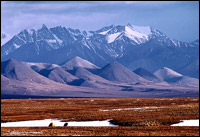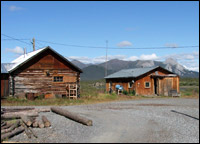David B. Williams is a freelance natural-history writer based in Seattle. He is the author of The Street-Smart Naturalist: Field Notes from Seattle and has written for Smithsonian, Popular Mechanics, National Parks, and The Seattle Times.

Friday, 29 Jul 2005
SEATTLE, Wash.
The Arctic National Wildlife Refuge is at the center of one of the most contentious environmental and political debates of our time. Yet few people know much beyond the rhetoric, and far fewer will actually visit the Arctic Refuge.

The most hotly disputed chunk of land in the U.S. of A.
Photo: U.S. Fish & Wildlife Service.
The University of Washington, however, is trying to remedy this situation, at least for one group of students. Twelve graduate and undergraduate students are taking part in an intensive, five-week class (“Choices and Change in the Arctic National Wildlife Refuge”) offered for the first time ever in summer 2005 by the Program on the Environment (POE), an interdisciplinary program on environmental studies.
“Environmental issues are uniquely interdisciplinary in that they draw upon the physical, biological, and social sciences, as well as the arts and humanities, in almost equal measure,” says POE co-director and course co-instructor David Secord. “The past, present, and future of the controversy over oil drilling in the refuge forms a perfectly packaged microcosm of critical regional and global sustainability issues.”
Central to this interdisciplinary approach is giving students the opportunity to become unusually well-informed about an issue and then providing them an opportunity to share the information. At the end of this course, students will develop a public exhibit to interpret their experiences and share their insights.
We’re spending the first week of the class in Seattle, learning about the politics and natural and cultural history of the refuge. Students and faculty will then fly to Alaska and spend a week rafting on either the Jago or Aichilik rivers, which flow out of the Brooks Range across the controversial 1002 area (where drilling would occur in the refuge) to the Beaufort Sea. The class will also meet with members of the two Native groups most affected by potential drilling, the Inupiat and Gwich’in, as well with biologists, geologists, and staff from the offices of Alaska Sen. Lisa Murkowski (R) and Washington Sen. Maria Cantwell (D).
As part of the course, they also decided to ask a journalist to tag along — me.
(One quick note: I will not use the term ANWR throughout these Dispatches. As several people who are deeply involved with the issue told me, ANWR is a term coined by industry, and it sounds too much like war. More important, the acronym ANWR conceals the fact that this landscape is a national wildlife refuge, federally protected “for the purpose of preserving unique wildlife, wilderness, and recreational values.”)
“This course is probably unlike any you have taken and is unlike any I have taught,” says Nate Mantua in his class introduction. Lead instructor and a research scientist at the NOAA/UW Joint Institute for the Study of the Atmosphere and Ocean, Mantua’s specialty is long-term climate patterns, such as El Niño and the Pacific Decadal Oscillation. “Our goal is to attempt to tackle many difficult issues and wrap them into one package. This is going to be an exciting experiment.”
Mantua asks the students to share their backgrounds and state their top issues for the refuge. “Caribou, jobs, native peoples, and energy independence,” says Dustin Andres, a senior in the Henry M. Jackson School of International Studies. Others add tourism, ecosystem balance, drilling impacts, climate change, plant and animal sustainability, and wilderness values. The 12 men and women include students in programs as diverse as marine affairs, conservation biology, geology, environmental science and resource management, political science, and economics.
Two nonstudents also sit in on the class and will join the group in the refuge. Ned Backus and Phil Stoller are board members of the Seattle-based Lucky Seven Foundation, which supports social services around Puget Sound. Although the foundation was approached for $5,000, the Lucky Seven ended up providing $13,500 for scholarships for students to participate in the class. “We were already supporting the Subhankar Banerjee show at the Burke [Museum of Natural History and Culture] and this was a logical extension,” says Backus. “Plus, we wanted to make sure that students of need could attend.” In addition, the UW Earth Initiative, the UW Summer School, and Tom Campion, cofounder of Zumiez, provided funding for the course.

Arctic Village, where life is all about caribou.
For the next six classes, we delve into the issues. Each day revolves around a single subject, beginning with culture. Only 7,500 people live in the North Slope region of Alaska, the area north of the Brooks Range and equal roughly in size to the state of Minnesota. Two towns dominate the issues in the refuge, maritime-oriented Kaktovik, which is on Barter Island in the Beaufort Sea, and caribou-focused Arctic Village, at the southern edge of the Brooks Range. Kaktovik has a little over 250 residents, 85 percent of whom are Inupiat. It is the only community in the refuge. Arctic Village’s 150-plus residents are Gwich’in Indians, more closely related to Navajo than Inupiat.
Tuesday we turn to geology. Drilling in the refuge can only occur on the coastal plain, the land between the Beaufort Sea and Brooks Range and commonly referred to as the 1002 (“ten-oh-two”) area, because it was designated by section 1002 of the Alaska National Interest Lands Conservation Act, which created the Arctic National Wildlife Refuge.
In the words of Bob Swenson, deputy director of research for Alaska’s Division of Geological and Geophysical Surveys, “Things really get complicated” in the 1002 area, in part because two very different geologic systems — a rift and a convergence zone — collide along the coastal plain. At least nine studies have been done with estimates of between 100 million and 49.5 billion barrels of oil, not all of which would be economically recoverable. The most recent study, by the U.S. Geological Survey in 1998, estimated a 50/50 chance of 7.7 billion barrels of technically recoverable oil.
Part of the estimation challenge is that only one well has been drilled inside the 1002 boundaries and the information obtained from it is a closely held secret. (Intriguingly, the two companies who do know what came up in that well, ConocoPhillips and BP, have pulled out of funding Arctic Power, an industry financed group that promotes oil development in the refuge.)
The highlight of the first week is a class led by Gordon Orians, UW emeritus professor of biology and chair of an 18-member National Research Council panel that in 2003 assessed the cumulative effects of oil extraction on Alaska’s North Slope. In a quiet yet passionate voice, Orians describes how the panel developed an unbiased, rigorously reviewed, scientifically based report. And then he launches into his concerns:
- Anthropogenic food sources from oil operations have led to an increase in predators, such as arctic fox, ravens, and glaucous gulls, which prey on nesting birds.
- What happens to lakes when they are drained 85 percent to make ice roads? There are regulations to govern this activity, but no data to support the regulations’ requirements.
- There are pervasive effects from seismic exploration, including disturbance of bowhead whales and polar bears. Again, there is no data to support regulations governing seismic surveys.
- For reasons unknown, the Porcupine caribou seem especially vulnerable to disturbance.
- No money has been set aside for cleanup after the oil runs dry.
- The biggest changes resulting from drilling in the North Slope have been cultural, with a radical alteration in social structure. As one Native told Orians, “We have money and electricity, but at what price?”
He concludes by saying, “One would wish that the debate wasn’t about the nutty stuff and would be about the real issues.”
Three days from now, 17 of us will be heading to Alaska to continue learning about these “real issues.”

